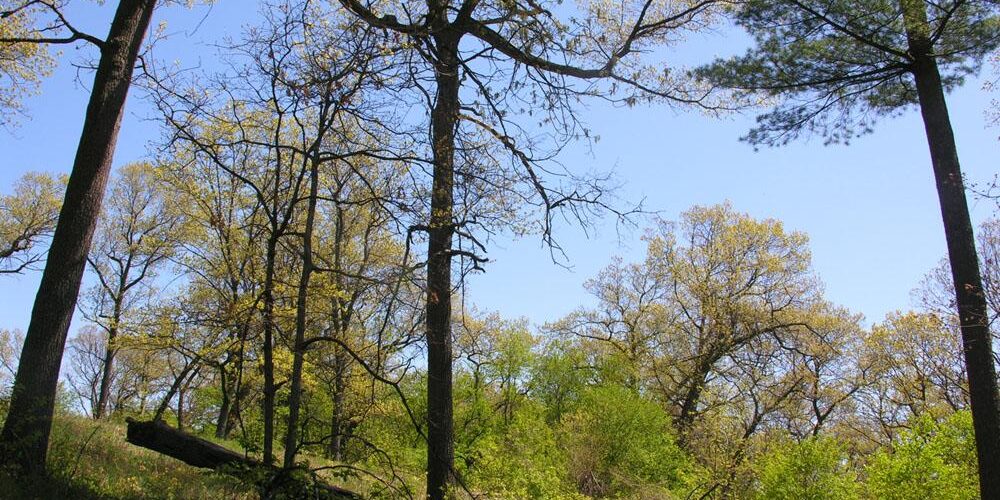by Kathleen Keefe
If you’d like to go back in time to see an ecosystem that is just about the same as it was thousands of years ago, look no further than High Park’s black oak savannah. This pastoral grassland dotted with magnificent oaks once covered two million hectares of what is now Ontario. Today less than 0.5% of that original landscape remains intact, but right here in High Park you can see one of the last sizeable existing remnants.

Legacy of Original Land Lovers
We are very fortunate heirs of this rare remnant ecosystem, intact and easy to reach right here in Canada’s largest city – at least 4000 years old and counting! Thousands of years back, the black oak savannah took hold on land flattened by glaciers and left sandy by the receding Lake Iroquois. The Indigenous people cared for and tended the land, living their lives integrated with this ecosystem. The black oak savannah is dependent on fire and would constantly be on its way to becoming a woodland without it. For thousands of years the Indigenous inhabitants set judiciously timed and managed fires that sustained the abundance, balance and vitality of the black oak savannah flora and fauna.
When Europeans arrived on the scene, they sized up the advantages of farming and developing the sparsely treed grassland compared to the surrounding woodlands, and expediently began repurposing the savannah. Among those Europeans who settled in Toronto were John and Jemima Howard who lived on land that they later deeded to the city to establish High Park, stipulating that it be kept public and natural. As a result, High Park’s black oak savannah remained mostly untouched as Toronto grew up all around it.

Fire to the Rescue
Black oaks and their savannah companion plants welcome fire. The oak leaves themselves contain combustible chemicals. When the leaves fall to the ground, they dry and curl, forming a crispy air-pocketed litter layer that encourages flames to catch and spread quickly. Together with the previous season’s dried tall grasses, they fuel the fires that nourish the ecosystem. Black oaks survive a fire and then thrive where the competition does not. These oaks develop a thick fire-resistant insulating bark and have a unique ability to re-sprout extra stems after a fire sweeps through. When a young oak is exposed to fire, it rebounds with a multi-stemmed trunk and bushy exuberant growth. (Most of the black oaks you see in High Park today have only single-stemmed trunks because they grew up in an era of fire suppression.)
The rest of the black oak savannah plant community also benefits from occasional fire because it clears excess accumulation of ground litter, releases growth-promoting nitrogen and blackens soil. The black soil then warms up in the sun and stimulates germination and regrowth. Regular controlled burns have been a consistent practice in High Park’s black oak savannah since 2000.
The Root Causes of Survival
High Park’s savannah is named after its most prominent tree, but it is the tall grasses and forbs that dominate the plant community in the wide open spaces between the scattered oaks. These sun-loving, drought-tolerant species thrive in the nutrient-poor soil of the black oak savannah. The tall native grasses are forced to grow long moisture-seeking root systems that can reach three or four metres below ground. When you see the beautiful tall grasses reaching skyward a metre and a half, use your imaginary x-ray vision to see three times that biomass extending beneath the ground! These are root systems that laugh at fire and drought. Savannah plants have narrow waxy leaves that minimize the surface area exposed to the parching sun, while the undersides of black oak leaves and the seedlings themselves are fuzzy in order to maximize the capture of available moisture.
Riches of Niches
Growing out in the open in full sun, a young oak will develop a magnificent bushy crown and vast lower limbs spreading out broadly. One of the reasons the black oak savannah is so rich in species diversity is because the deep shade beneath the oaks and the full sun between them offer three different growing conditions for three distinct plant communities: the grasses and forbs flourish in the full sun between the oaks; wildflowers and various shrubs seek the denser shade beneath the oaks; while other plants want the partial shade found within the margins of the two extremes. Also, the black oak savannah itself is a transitional zone between prairie and woodland and can contain the plant species of all three ecosystems; the edges where savannah borders prairie or woodland are particularly rich in plant diversity. With so many unique combinations of growing conditions, High Park’s black oak savannah attracts and shelters dozens of rare plants and many birds, small animals and insects, including around 40 different kinds of butterflies.





















